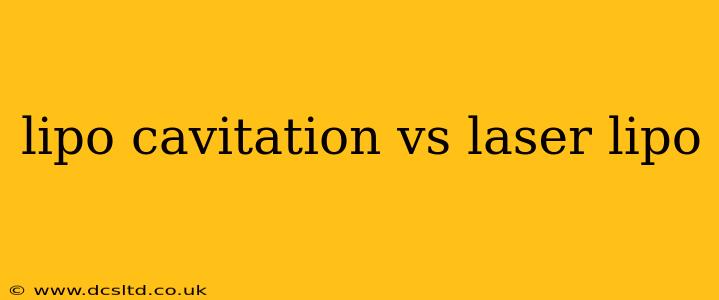Choosing between lipo cavitation and laser lipo can feel overwhelming. Both are non-invasive fat reduction treatments promising a slimmer physique, but they work through different mechanisms. This comprehensive guide will delve into the specifics of each procedure, highlighting their differences, benefits, and potential drawbacks to help you make an informed decision.
What is Lipo Cavitation?
Lipo cavitation uses ultrasound technology to break down fat cells. A device emits low-frequency ultrasound waves that create cavitation bubbles within the fat cells. These bubbles implode, effectively destroying the fat cells, which are then naturally processed and eliminated by the body's lymphatic system. The procedure is typically painless, although some patients report mild discomfort or warmth during the treatment.
Advantages of Lipo Cavitation:
- Non-invasive: No incisions or needles are involved.
- Relatively painless: Most patients find the procedure comfortable.
- Multiple treatment areas: Can target various body parts simultaneously.
Disadvantages of Lipo Cavitation:
- Multiple sessions needed: Results are usually gradual and require several treatment sessions.
- Not suitable for everyone: Individuals with certain medical conditions, such as heart problems, may not be suitable candidates.
- Limited fat reduction: While effective, it may not be as effective as surgical liposuction for significant fat reduction.
What is Laser Lipo?
Laser lipo, also known as laser lipolysis, utilizes laser energy to melt away fat cells. A laser is applied to the treatment area, heating and breaking down the fat cells. This process triggers the release of fatty acids, which are then naturally metabolized and removed by the body. Similar to cavitation, laser lipo is a non-invasive procedure that doesn’t require incisions or needles.
Advantages of Laser Lipo:
- Skin tightening: Laser energy can stimulate collagen production, leading to skin tightening in the treated area.
- Faster results: Some patients see more noticeable results compared to cavitation, although multiple sessions might still be necessary.
- Targeted treatment: Laser lipo allows for precise targeting of specific fat deposits.
Disadvantages of Laser Lipo:
- Potential side effects: Mild side effects, such as redness, swelling, and bruising, are possible.
- Cost: Laser lipo can be more expensive than lipo cavitation.
- Not a weight-loss solution: Both laser lipo and cavitation are not substitutes for a healthy diet and exercise.
How Much Fat Can Each Procedure Remove?
The amount of fat removed by both lipo cavitation and laser lipo varies depending on individual factors such as the amount of fat to be reduced, the number of sessions, and adherence to post-treatment recommendations. Generally, neither procedure is designed to remove large amounts of fat in a single session. They are most effective for tackling smaller, stubborn fat pockets that are resistant to diet and exercise.
Which Procedure is Better?
There's no single "better" procedure; the ideal choice depends on individual needs and preferences. Factors to consider include your specific concerns, budget, and medical history. Consulting with a qualified medical professional is crucial before making a decision. They can assess your body composition, discuss your goals, and recommend the most appropriate treatment option.
Is there any downtime with either procedure?
Generally, both lipo cavitation and laser lipo involve minimal downtime. Most patients can resume their normal activities immediately after the procedure, although some mild discomfort or bruising may occur.
What are the risks and side effects?
While both procedures are considered safe, potential side effects exist. These may include temporary redness, swelling, bruising, and pain at the treatment site. Rarely, more serious complications can occur. It's crucial to choose a reputable clinic with experienced practitioners to minimize the risks.
Are the results permanent?
The results of both lipo cavitation and laser lipo are not permanent. Maintaining a healthy lifestyle through diet and regular exercise is essential to prevent fat accumulation in the treated areas.
By carefully considering the advantages and disadvantages of each procedure, and by consulting with a qualified practitioner, you can make an informed decision about which non-invasive fat reduction treatment is right for you. Remember that consistent healthy habits are crucial for long-term results.
